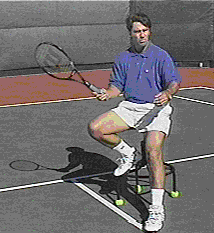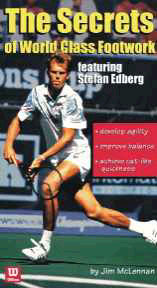|
TennisOne Lessons


The Classic Volley
A Lost Art in Today's Game?
Jim McLennan
 The Volley - Does anyone remember how it looks, certainly not if you are watching professional tennis these days. A long rally, movement from side to side, the opponent is out of position and slightly off balance, Conners swoops to the net, stroking the midcourt volley heavily into the open court. If there is a reply, Jimbo angles off a nifty winner. Then there was McEnroe, Edberg, and now Rafter. But for those of us who learned and played in the 60's and 70's the net game was everything, daring, creative, split second, and down right fun. The Volley - Does anyone remember how it looks, certainly not if you are watching professional tennis these days. A long rally, movement from side to side, the opponent is out of position and slightly off balance, Conners swoops to the net, stroking the midcourt volley heavily into the open court. If there is a reply, Jimbo angles off a nifty winner. Then there was McEnroe, Edberg, and now Rafter. But for those of us who learned and played in the 60's and 70's the net game was everything, daring, creative, split second, and down right fun.
The modern semiwestern grips, with its incredible ball speed have negated the net game (it is hard to find the continental grip from a semiwestern base, and when groundies and approaches are struck so hard there is less time for the actual net rush) but for the remainder of us mortals, there still is much to be learned from and enjoyed at the net.
Tom Stow trained the volley from a stool. Continental grip, very slight turn, feet either on the stool or planted lightly on the ground - EVERYTHING WAS STILL; head, shoulders, torso, just the forearm and racquet would play against the ball. This special feeling of "centeredness" learned from a stool ingrained a feeling of balance, not reaching, or lunging, but control. That was the key.
 This is the base from which the stroked volley and angled volley are learned - immediate preparation, short heavy stroke, total attention to the racquet face. On preparation the racquet face must be exactly aligned with the path of the incoming ball. This preparation must be done quickly enough so the player can actually feel a pause before the forward stroke. The pause is all about timing, no reaching, or lunging, but simply waiting for the ball. The stroke is short, feeling the weight of the forearm against the ball, and the stroke stops abruptly, with the strings facing the path of the incoming ball. This is the base from which the stroked volley and angled volley are learned - immediate preparation, short heavy stroke, total attention to the racquet face. On preparation the racquet face must be exactly aligned with the path of the incoming ball. This preparation must be done quickly enough so the player can actually feel a pause before the forward stroke. The pause is all about timing, no reaching, or lunging, but simply waiting for the ball. The stroke is short, feeling the weight of the forearm against the ball, and the stroke stops abruptly, with the strings facing the path of the incoming ball.
Volleys are hit with backspin, which makes for a lower bounce and reduces the opponents time and angle making passing shots more difficult (the same can be said for the approach and many can surely remember Edberg's elegant underspin backhand approaches). To spin the volley, open the strings ever so slightly, and feel the cut the open face creates. Once the feel of this stroke is mastered, and this can take some time, get off the stool. Turn slightly, prepare the strings immediately along the flight of the incoming ball, pause, and then step and hit if you choose, but the timing and weight of the forearm will give you all the snap you will ever need.
Your comments are welcome. Let us know what you think about
Jim McLennan's article by emailing
us here at TennisOne.

|

|
The Secrets of World Class Footwork - Featuring
Stefan Edberg
by Jim McLennan
Learn the secret to the quickest start to the ball, and the secret
to effortless movement about the court.
Includes footage of
Stefan Edberg, one of the quickest and most graceful of all the
professionals.
|

|
|
Learn pattern movements to the volleys, groundstrokes, and
split step reactions. Rehearse explosive starts, gliding movements,
and build your aerobic endurance. If you are serious about improving your tennis,
footwork is the key.
Includes video tape and training manual (pictured above). - $29.95
plus 2.50 shipping and handling
|
|
|

 The Volley - Does anyone remember how it looks, certainly not if you are watching professional tennis these days. A long rally, movement from side to side, the opponent is out of position and slightly off balance, Conners swoops to the net, stroking the midcourt volley heavily into the open court. If there is a reply, Jimbo angles off a nifty winner. Then there was McEnroe, Edberg, and now Rafter. But for those of us who learned and played in the 60's and 70's the net game was everything, daring, creative, split second, and down right fun.
The Volley - Does anyone remember how it looks, certainly not if you are watching professional tennis these days. A long rally, movement from side to side, the opponent is out of position and slightly off balance, Conners swoops to the net, stroking the midcourt volley heavily into the open court. If there is a reply, Jimbo angles off a nifty winner. Then there was McEnroe, Edberg, and now Rafter. But for those of us who learned and played in the 60's and 70's the net game was everything, daring, creative, split second, and down right fun.  This is the base from which the stroked volley and angled volley are learned - immediate preparation, short heavy stroke, total attention to the racquet face. On preparation the racquet face must be exactly aligned with the path of the incoming ball. This preparation must be done quickly enough so the player can actually feel a pause before the forward stroke. The pause is all about timing, no reaching, or lunging, but simply waiting for the ball. The stroke is short, feeling the weight of the forearm against the ball, and the stroke stops abruptly, with the strings facing the path of the incoming ball.
This is the base from which the stroked volley and angled volley are learned - immediate preparation, short heavy stroke, total attention to the racquet face. On preparation the racquet face must be exactly aligned with the path of the incoming ball. This preparation must be done quickly enough so the player can actually feel a pause before the forward stroke. The pause is all about timing, no reaching, or lunging, but simply waiting for the ball. The stroke is short, feeling the weight of the forearm against the ball, and the stroke stops abruptly, with the strings facing the path of the incoming ball. 
